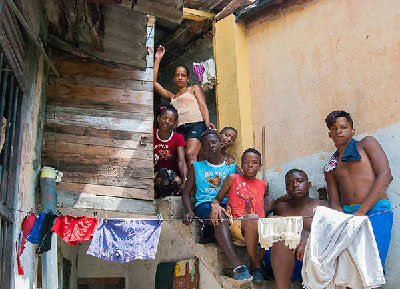By Fernando Ravsberg, Havana Times, April 23, 2013
 |
| Cuba’s shantytowns and tenement buildings, where extremely poor living conditions prevail, are populated chiefly by black people. Photo: Raquel Perez |
In 1925, Las Margaritas, the birthplace of Cuban singer Celia Cruz, was one of Havana’s poor black neighborhoods. Today, the children who live in this shantytown have free access to education and healthcare, but little of the deplorable living conditions that prevailed back then has changed, and its inhabitants are still, for the most part, of the same skin color.
León Mago Rodríguez, of African descent, has lived in the shantytown for 60 years. His daughters, who also grew up there, had to build additional rooms for themselves when they turned of age. For lack of space, his grandchildren constructed their quarters over the roof of the house, where the great-grandchildren can be seen running and playing about.
The few public and reliable statistics available in Cuba show that, today, black people live in the country’s worst houses, receive less remittances and hard currency, are less active in the country’s emergent economy, have lower university enrollment indexes and tend to be employed in the worst-paying jobs available.
In the 1960s, the Cuban government declared it had resolved the racial problem definitively. In an article recently published by the New York Times, however, intellectual Roberto Zurbano condemned today’s racial discrimination on the island. “I did it to spark off a broad debate about racism,” he explains.
Metastasis
Race has been a sensitive issue since colonial times. Fear of the black man, in fact, is one of the arguments used to explain Cuba’s relatively late start in the struggle for independence. In 1959, Fidel Castro’s public condemnation of racism provoked such a strong reaction among the population that he had to address the issue again, days later.
Even today, the issue is seldom addressed by the Cuban press or in public speeches. President Raul Castro has, however, promoted a quota-based policy aimed at increasing the number of black women and men in leadership positions.
The relatively high number of black people in Cuban jails reveals that a “racial problem” still exists in the country.
Institutionally speaking, all races have the same opportunities for personal development in Cuba. In fact, a number of individuals of African descent have reached high positions within the government. A case in point is Esteban Lazo, a working-class black man born in the countryside, who is today the Chair of the Cuban parliament.
The general rule, however, is that most prisons and poor neighborhoods are filled with black people, while white people continue to advise their peers not to “do things like blacks do” and some Cubans of African descent insist that interracial marriages are a way of “moving up the racial ladder”.
A Sensitive Issue
In the internal debates re-opened by the New York Times article, Cuban professor Guillermo Rodríguez wrote that “it is dishonest” not to acknowledge that the revolution fought against racism by creating opportunities in the workforce, the media and education for Cubans of all races.
According to Zurbano, black people in Cuba were never equally empowered to take advantage of those opportunities, asking, as way of an example: “How could we even think of renting out our home or opening a restaurant in it if we live in the shabbiest of houses?”
“My article was misread. I recognize that we, in Cuba, enjoy many of the rights that other African descendants in the region continue to demand, such as health and education. But I demand that the history of Africa be included in the history syllabus.”
Zurbano proposes that a debate on these issues be opened. “The first thing to do is to hold a debate, among Cubans, on the basis of the data that has already been collected by research centers. But we need to get experts and political activists together, so as to discuss the results yielded by that research.”
A Taboo Subject and the Debate
Roberto Zurbano has opened a broad debate on the racial issue. Foto: Raquel Perez
Cuban professor Esteban Morales, who is also of African descent, believes the government is already open to such debates. “That’s why I don’t agree with Zurbano. The discussion is already underway. I do agree it needs to be broadened, that it needs to reach further down, to the base.”
His proposal is the creation of a State department responsible for racial issues. He points out that “women have been a priority since the beginning. The racial issue must be tackled through cultural, economic and government activities.”
Renowned racial activist Tato Quiñones, an intellectual and Babalao (Santería priest), acknowledges that the struggle against racial discrimination in the workplace and educational and recreational institutions began in 1959. “That’s when the revolution took on special meaning for me,” he states.
He adds that black people benefitted from the progressive social measures that were taken in favor of the underprivileged, such as free education and healthcare and the right to employment, but that that “no extraordinary policies were implemented to aid that sector of the population that was in dearest need of it.”
“It was a mistake to believe that the elimination of social classes would, in and of itself, put an end to racism,” Quiñones said, criticizing the taboos that surround the racial debate in Cuba. He acknowledges that Zurbano is to be commended for “putting the racial issue back on the table, at his own risk.”
—–
(*) A Havana Times translation of the original published on the blog of Fernando Ravsberg.
—–
(*) A Havana Times translation of the original published on the blog of Fernando Ravsberg.
No comments:
Post a Comment